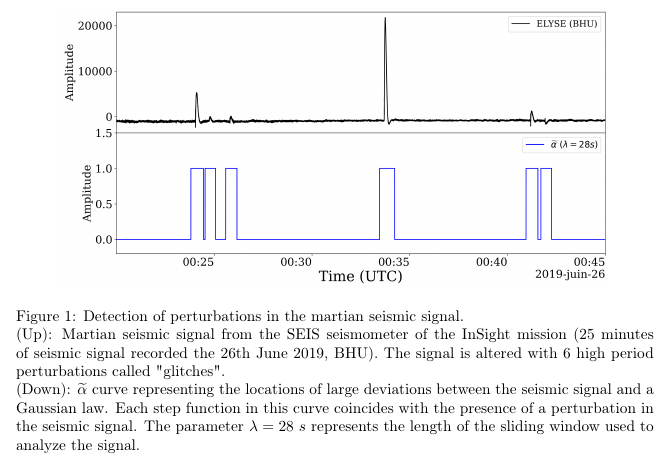Non Gaussian transient waveform detections in the martian continuous signal
- 1LPG, Nantes University, Nantes, France
- 2Institut Supérieur de l'Aéronautique et de l'Espace, Toulouse, France
Introduction
The detection of transient waveforms generated by earthquakes began with the deployment of seismometers on the Earth's surface in the early 20th century. With the development of digital seismographs, various seismic detectors have been proposed: IBM, ``Z'', Deflection, Allen, Walsh (among many others, see [3] for a detailed review). Among them we can cite the studies focusing on statistical methods to detect for instance weak features in the continuous signal (e.g. [2]), but also new event detectors based on statistical approaches, template matching or machine learning (e.g [7-6-9]). Due to the primary interest of seismic event detection, developed methods are dedicated to locating rapid impulsive signals in a background signal that is supposed to be gaussian at least for periods larger than 10~seconds [4] and very few of them are used to quantify the gaussianity or non-gaussianity of the continuous seismic signal. We developed a new method to quantify local Gaussianity for a given time window. Using various window lengths that are sliding with time, this approach can be used to investigate the gaussianity. Based only on a statistic criterion, a direct consequence of this new method is the detection of any deviation to the normal law distribution that is governing the whole background seismic signal. The applications presented in this study focuses on the martian signal recorded by the SEIS instrument from the InSight mission [10], [8]. By comparing the seismic signal with reference time series, we propose here a statistical threshold detecting the Gaussian deviations exceeding 3 times the standard deviation defined when the signal is perfectly Gaussian. This statistical frame enables us to extract many perturbations in any seismic signal and the statistical threshold is an efficient way to avoid ad hoc thresholds.
Results
The detection of the different perturbations recorded by the SEIS instrument allows a statistical analysis on the number of perturbations per martian day and their location in time. By analysing the continuous martian signal recorded during the InSight mission, our new approach highlights its non-Gaussian parts, which leads to the localization of differents perturbations. The result of this sliding window method is an α curve whose values are 0 when the local signal is Gaussian and 1 otherwise, which indicates the presence of a perturbation as shown in figure 1.

This original approach meets various applications with the martian data from the SEIS station [10], because of the rough environnement (harsh winds, temperature variations of 60°C in one martian day, ...) leading to many alterations in the seismic signal, like pressure drops or glitches presented in figure 1 (see [5] and [1]).
This work aims to focus on the statistical analysis of these non-Gaussian perturbations. A thorough study of their time location during a full martian day is completed in order to estimate the quality of the SEIS signal hour per hour. On the other hand, a comparison of the amount of the daily perturbations over several months is completed in order to highlight the seasonnal influence on the quality of the recorded data. Additionnaly, an analysis of these perturbations using clustering methods is also performed.
Conclusion
We show in this work that quantifying the deviation of the signal to a Gaussian law seems to be an efficient tool to locate the damaged parts of the signal, and therefore the different perturbations altering a seismic signal. Although this method may be applied to terrestrial seismic signal, the present study focused here on the martian seismic signal from the InSight mission. This approach have made it possible to extract the different perturbations recorded by the SEIS instrument. Applying this method over a large period of time, we obtain an inventory of the perturbations altering the martian seismic signal. Finally, analyzing the statistics of the perturbations altering the signal leads to a better comprehension of the behaviour of the first seismic signal ever recorded on Mars and the SEIS instrument itself.
How to cite: Cuvier, A., Beucler, É., Bonnin, M., and Garcia, R.: Non Gaussian transient waveform detections in the martian continuous signal, Europlanet Science Congress 2022, Granada, Spain, 18–23 Sep 2022, EPSC2022-797, https://doi.org/10.5194/epsc2022-797, 2022.

